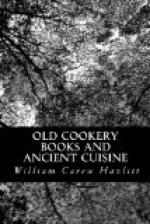In a glossary of the tenth-eleventh century only two meals are quoted: undermeat = prandium, and even-meat = coena. That is to say, our Saxon precursors were satisfied as a rule with two repasts daily, but to this in more luxurious times were added the supper and even the rear-supper, the latter being, so far as we know, a second course or dessert and the bipartite collation corresponding to the modern late dinner. But it is one of those strange survivals of ancient manners which people practise without any consciousness of the fact, which is at the root of the fashion, which still occasionally prevails, of dividing the chief meal of the day by an interval of repose, and taking the wine and dessert an hour or two after the other courses; and the usage in our colleges and inns of court of retiring to another apartment to “wine” may claim the same origin. It is obvious that the rear-supper was susceptible of becoming the most important and costly part of an entertainment; and that it frequently assumed extravagant proportions, many passages from our early poets might be adduced to prove.
In the “Book of Cookery,” 1500, we have the menu at the installation of Archbishop Nevill in York in 1467; but the bill of fare of a feast given by him in 1452 at Oxford, where he is mentioned as Master Nevill, son of the Earl of Salisbury, is inserted from the Cotton MS. Titus, in “Reliquiae Antiquae,” 1841. It consisted of three courses, which seem to have been the customary limit. Of course, however, the usage varied, as in the “Song of the Boar’s Head,” of which there are two or three versions, two courses only are specified in what has the air of having been a rather sumptuous entertainment.
The old low-Latin term for the noonday meal was merenda, which suggests the idea of food to be earned before it was enjoyed. So in “Friar Bacon’s Prophesie,” 1604, a poem, it is declared that, in the good old days, he that wrought not, till he sweated, was held unworthy of his meat. This reminds one of Abernethy’s maxim for the preservation of health,—to live on sixpence a day, and earn it.
The “Song of the Boar’s Head,” just cited, and printed from the Porkington MS. in “Reliquiae Antiquae” (ii, 30), refers to larks for ladies to pick as part of the second course in a banquet. On special occasions, in the middle ages, after the dessert, hippocras was served, as they have liqueurs to this day on the Continent both after dinner and after the mid-day breakfast.
The writer of “Piers of Fulham” lived to see this fashion of introducing a third meal, and that again split into two for luxury’s sake; for his metrical biographer tells us, that he refused rear-suppers, from a fear of surfeiting.
I collect that in the time of Henry VIII. the supper was a well-established institution, and that the abuse of postponing it to a too advanced hour had crept in; for the writer of a poem of this period especially counsels his readers not to sup late.




